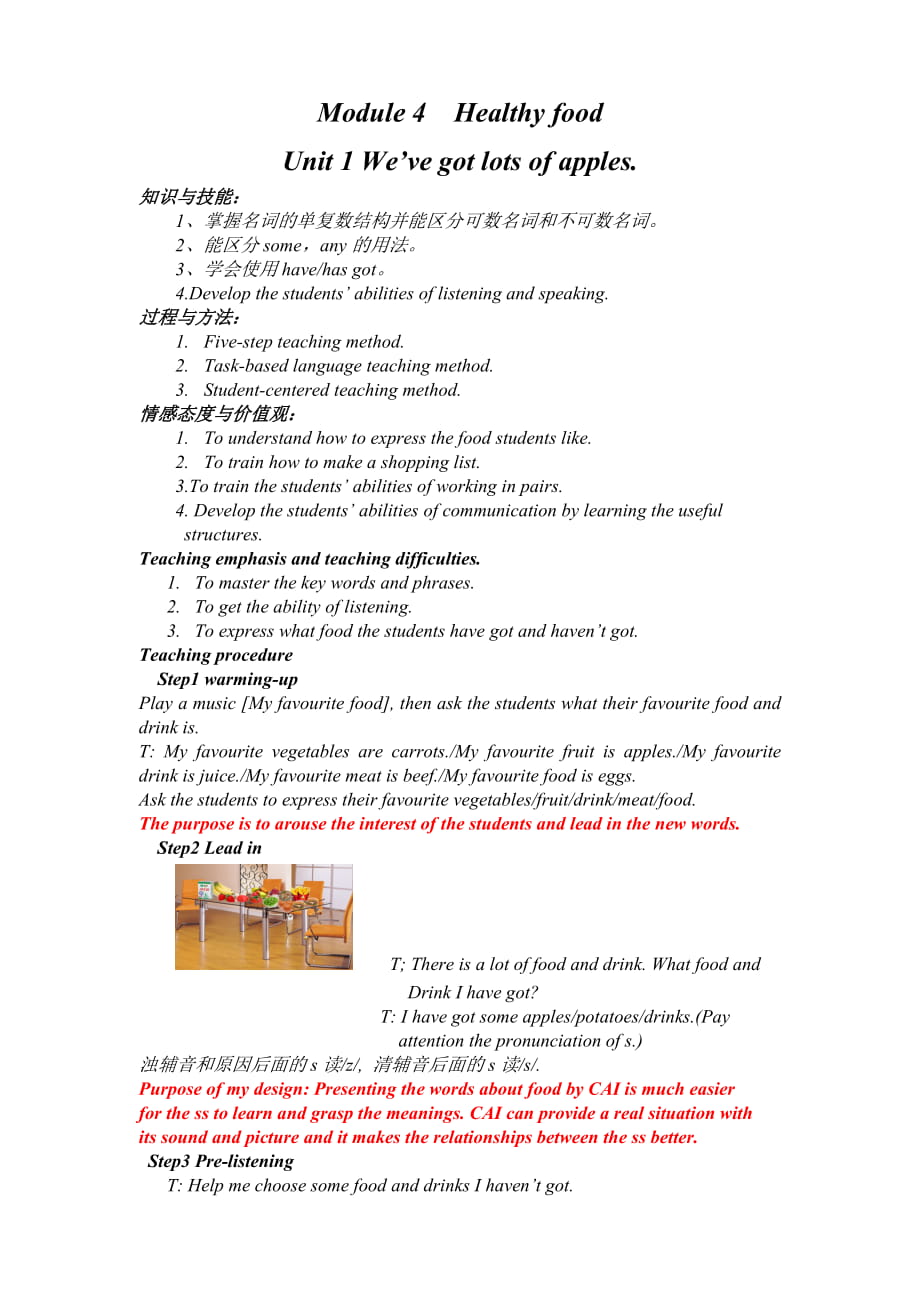《外研版七年級英語上冊Module 4 unit1 We've got lots of apples.教案 (2)》由會員分享�,可在線閱讀,更多相關(guān)《外研版七年級英語上冊Module 4 unit1 We've got lots of apples.教案 (2)(3頁珍藏版)》請?jiān)谘b配圖網(wǎng)上搜索�。
1、Module 4 Healthy food
Unit 1 We’ve got lots of apples.
知識與技能:
1�、掌握名詞的單復(fù)數(shù)結(jié)構(gòu)并能區(qū)分可數(shù)名詞和不可數(shù)名詞。
2����、能區(qū)分some,any的用法����。
3�、學(xué)會使用have/has got��。
4.Develop the students’ abilities of listening and speaking.
過程與方法:
1. Five-step teaching method.
2. Task-based language teaching method.
3. Student-centered t
2���、eaching method.
情感態(tài)度與價(jià)值觀:
1. To understand how to express the food students like.
2. To train how to make a shopping list.
3.To train the students’ abilities of working in pairs.
4. Develop the students’ abilities of communication by learning the useful
structures.
Teaching emphasis and teac
3��、hing difficulties.
1. To master the key words and phrases.
2. To get the ability of listening.
3. To express what food the students have got and haven’t got.
Teaching procedure
Step1 warming-up
Play a music [My favourite food], then ask the students what their favourite food and drink is.
T
4����、: My favourite vegetables are carrots./My favourite fruit is apples./My favourite drink is juice./My favourite meat is beef./My favourite food is eggs.
Ask the students to express their favourite vegetables/fruit/drink/meat/food.
The purpose is to arouse the interest of the students and lead in th
5��、e new words.
Step2 Lead in
T; There is a lot of food and drink. What food and
Drink I have got?
T: I have got some apples/potatoes/drinks.(Pay
attention the pronunciation of s.)
濁輔音和原因后面的s讀/z/, 清輔音后面的s讀/s/.
Purpose of my design: Present
6�����、ing the words about food by CAI is much easier
for the ss to learn and grasp the meanings. CAI can provide a real situation with
its sound and picture and it makes the relationships between the ss better.
Step3 Pre-listening
T: Help me choose some food and drinks I haven’t got.
Let’s get some
7�、/what about some…. Because it’s/they are…
The purpose is to make the students understand the listening material more easily and deal with the difficult language points.
Step4 while-reading
Task1. Listen and choose a picture about the food Tony’s family has got. (選出Tony家已有食物的圖片)
Tony has got so
8、me_______ .
(A) (B) (C)
Task 2 :Listen and circle the things Tony’family hasn’t got.
(圈出Tony家沒有的食物��。)
meat chicken oranges
orange juice milk coffee
cola
9����、 tea potatoes
Tip2: listen for key words. (聽關(guān)鍵詞)
√
Task 3 : Listen and decide or according to the listening.
(根據(jù)聽力判斷正誤)
1. Tony’s mum hasn’t got any coffee.
2. Tony’s dad will buy(買) some cola.
3. Tony’s family hasn’t got any drinks.
The purpose is to tra
10����、in the ability of listening and get the main idea of the dialogue.
Step5 Imitation show
Tony: Ok. Have we got any chocolate?
Dad: Yes, we have.
Tony: What kind of fruit? Apples?
Dad: No, we’ve got lots of apples.
Dad:No cola! Cola is bad for you! How about some tea?
Tony: Oh, too bad!
The pu
11�����、rpose is to train the students’ pronunciation and intonation. :Audio-visual” teaching method and “Task-based” teaching method. In this way, the ss are full of self-confidence and eager to show off what they have learnt. It also helps them cultivate their team spirit.
Step6: Pair work
A: Has h
12�、e got any…?
B: Yes, he has. He has got some …/
No, he hasn’t. He hasn’t got any ….
A: …
The purpose is to review the dialogue and practice the sentence structure.
Step7: Survey and summary.
Please work in 3 to finish a shopping list. S1 makes a report first. Then S2 and S3 make a dia
13、logue.
My shopping list
Things you have got
Things you haven’t got
Food
apples
beef
Drink
orange juice
A: Let’s go shopping. Have we got any …?
B: Yes, we have./ No, we haven’t.
A: Ok. Let’s get some…/ How about some …?
B: Good idea!
A: ……
14����、
B: ……
The purpose : this part is very important that the ss should speak English as much as they can in class. It’s necessary for the students to investigate the others to consolidate the knowledge they learned.
Step8; Homework.
1. Make ten sentences by using “have/has got”.
2. Make a list what food and drink you have got and you haven’t got.
The purpose is to review the passage.
 外研版七年級英語上冊Module 4 unit1 We've got lots of apples.教案 (2)
外研版七年級英語上冊Module 4 unit1 We've got lots of apples.教案 (2)

